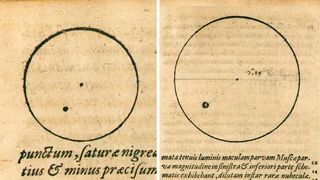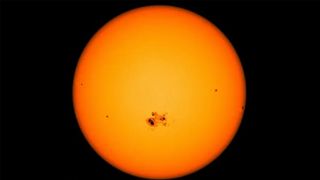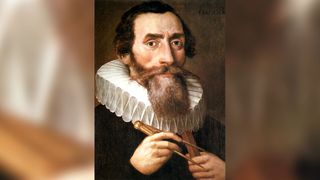Fragments of the Ribbeck meteorite are roughly 4.5 billion years old and smell a little like rotten eggs, scientists say in a new journal paper. They theorize that snow and thawing exposure explains the unpleasant aroma.
Fragments of a meteorite that blazed across the skies near Berlin in January are about 4.5 billion years old, scientists wrote in an article published in the Meteoritics & Planetary Science journal.
Named after the site of its discovery, researchers led by the Institute of Planetology at the University of Münster also found the Ribbeck meteorite belongs to the scarce class of aubrites.
They are so rare that only 11 other aubrite falls have been recorded, while 76 finds are listed in the meteorite database.
Ancient calling card from space
Scientists have examined the Ribbeck meteorite fragments closely, and they estimate that Ribbeck's parent body is approximately 4.5 billion years old.
It likely originated from the asteroid belt situated between Mars and Jupiter.
Curiously, the meteorite fragments emitted an intense smell of hydrogen sulfide, reminiscent of rotten eggs.
This odor results from chemical reactions between the mineral phases and moisture — likely caused by snow and thaw — altering the rock's mineralogy.
Meteorite treasure hunt
Ribbeck, initially named asteroid 2024 BX1, burned up on January 21 this year over Germany.
The first piece of the meteorite was only found days later.
"When searching for meteorites, you usually look for black rocks. However, due to their mineralogy and composition, the Ribbeck fragments did not have a consistently dark fusion crust," Addi Bischoff, one of the authors of the paper, explained.
"This is probably why numerous fragments were missed in the first days of the search, until this peculiarity was recognized," he said.
Scientists and collectors gathered 202 fragments weighing 1.8 kilograms in total.
lo/msh (dpa, epd)
News
Kepler's sun drawings are the oldest sunspot records with known dates.
When you purchase through links on our site, we may earn an affiliate commission. Here’s how it works.

"Half-forgotten" sunspot drawings by Renaissance astronomer Johannes Kepler are showing us more about how the sun's cycle of activities work.
Kepler (1571-1630), who was born in what we now call Germany, is best known in astronomy for formulating the laws of planetary motion. His diverse interests, however, included looking at the sun. Drawings he made of a sunspot group in 1607, a new study reveals, show the "tail-end of the solar cycle" with instrumentation before the telescope was more widely available in the early 17th century.
"The group's findings … offer a key to resolving the controversy on the duration of solar cycles at the beginning of the 17th century," Japan's Nagoya University wrote in a statement.
Known as the Maunder Minimum, this period (between 1645 and 1715) was said to be an era of fewer sunspots than usual, which in turn led to colder periods on Earth than the norm of the day.
RELATED: 'A wonderful spectacle': Photographer snaps rare solar eruption as 'magnetic noose' strangles the sun's south pole

Since Kepler lacked the telescope, he instead examined the sun using camera obscura. That method used a "small hole in a wall to project the sun's image onto a sheet of paper," the statement noted. Kepler at first thought he was witnessing a transit of Mercury across the sun, but later clarified it was a sunspot group.
"This is the oldest sunspot sketch ever made with an instrumental observation and a projection," lead author Hisashi Hayakawa, an assistant professor and solar scientist at Nagoya, said in a statement. He added the significance of Kepler's solar drawings was overlooked, over the eras: "It has only been discussed in the context of the history of science and had not been used for quantitative analyses for the solar cycles."
Sign up for the Live Science daily newsletter now
Get the world’s most fascinating discoveries delivered straight to your inbox.Contact me with news and offers from other Future brandsReceive email from us on behalf of our trusted partners or sponsorsBy submitting your information you agree to the Terms & Conditions and Privacy Policy and are aged 16 or over.
Key to the researchers' analysis was tracking how sunspots move across a solar cycle: "Their occurrence, frequency, and latitudinal distributions appear in cycles that affect solar radiation and space weather," the statement noted. As such, they worked to narrow down what latitude Kepler's sunspots were observed at.

The researchers say their analysis of Kepler's drawings revealed four major things.
First, the sunspot group was at a lower latitude than previously believed (after taking into account the solar position angle from his location); related to that, future findings in the telescope showed sunspots at higher latitudes, suggesting "a typical transition" between cycles.
The latitude change suggests the sunspot group was at the end of one solar cycle instead of the beginning of another, based on the latitude of the sunspots, which formulated the third finding.
Finally, Kepler's observations may show the transition zone between solar cycles, which the study pegged between 1607 and 1610.
—Rare, mystery blasts from sun can devastate the ozone layer and spike radiation levels on Earth
—Sun launches strongest solar flare of current cycle in monster X8.7-class eruption
—Gargantuan sunspot 15-Earths wide shoots powerful X-class flare toward Earth, triggering radio blackouts
While some researchers previously theorized the Maunder Minimum arose from irregular solar cycles different than the typical 11 years, Kepler's records showed "a regular duration" for the solar cycle he observed in 1607, the study added.
But the finding is not without controversy: tree ring cycles from previous studies have suggested normal solar cycles in some work, and abnormal solar cycles in others.
Hayakawa urged further examinations on the matter. "It is extremely important to check these [tree rings] reconstructions with independent – preferably observational – records," he said.
The new study was published in The Astrophysical Journal on July 25.
Originally posted on Space.com.
IAF’s Wing Commander Shubhanshu Shukla picked as ‘Prime Astronaut’ for Indo-US Mission to Space Station

Indian Air Force Wing Commander Shubhanshu Shukla has been selected as the prime astronaut for the upcoming Indo-US mission to the International Space Station (ISS), the Indian Space Research Organisation (ISRO) has announced.
A joint statement signed between India and the US during the official state visit of Prime Minister Narendra Modi in June 2023 envisioned a joint ISRO-NASA effort to the ISS.
Towards the goal of mounting a joint ISRO-NASA effort, the Human Space Flight Centre (HSFC) of ISRO has entered into a Space Flight Agreement (SFA) with NASA-identified service provider Axiom Space Inc, USA for its upcoming Axiom-4 mission to the ISS, the Indian space agency said on Friday.
A National Mission Assignment Board has recommended two Gaganyatris as prime and backup Mission Pilot for this mission. These include Group Captain Shubhanshu Shukla (Prime) and Group Captain Prasanth Balakrishnan Nair (Backup).
“The assigned crewmembers will be finally approved to fly to the International Space Station by the Multilateral Crew Operations Panel (MCOP),” ISRO statement read.
The recommended Gaganyatris will commence their training for the mission from the first week of August, ISRO said.
During the mission, the Gaganyatri will undertake selected scientific research and technology demonstration experiments on board the ISS as well as engage in space outreach activities. The experiences gained during this mission will be beneficial for the Indian Human Space Program and it will also strengthen human space flight cooperation between ISRO and NASA.
Gaganyaan project envisages a demonstration of human spaceflight capability by launching a crew of 3 members to an orbit of 400 km for a 3-day mission and bringing them back safely to earth, by landing in Indian sea waters.
In February this year, PM Modi announced the names of the four chosen Indian Air Force pilots; Group Captain Prashanth Nair, Group Captain Ajit Krishnan, Group Captain Angad Pratap, and Wing Commander Shubhanshu Shukla who would be part of India’s first human space flight programme. It is slated to be launched in 2024-25.
The four astronauts were trained at Yuri Gagarin Cosmonaut Training Centre in Russia. Prime Minister Narendra Modi, had reviewed the progress of the Gaganyaan mission and bestowed ‘astronaut wings’ to the astronaut-designates at Vikram Sarabhai Space Centre.
The Gaganyaan mission is India’s first human space flight program for which extensive preparations are underway at various ISRO centres.
“India’s success in the space sector is sowing the seeds of scientific temperament in the country’s young generation,” PM Modi said in his address at the Vikram Sarabhai Space Centre.
The pre-requisites for Gaganyaan mission include development of many critical technologies including human rated launch vehicle for carrying crew safely to space, Life Support System to provide an earth like environment to crew in space, crew emergency escape provision and evolving crew management aspects for training, recovery and rehabilitation of crew.
Various precursor missions are planned for demonstrating the Technology Preparedness Levels before carrying out the actual Human Space Flight mission. These demonstrator missions include Integrated Air Drop Test (IADT), Pad Abort Test (PAT) and Test Vehicle (TV) flights. Safety and reliability of all systems will be proven in unmanned missions preceding manned mission.
LVM3 rocket – The well proven and reliable heavy lift launcher of ISRO, is identified as the launch vehicle for Gaganyaan mission.
Human safety is of paramount importance in Gaganyaan mission. In order to ensure the same, various new technologies comprising of Engineering systems and Human centric systems are being developed and realised.
In 2023, in a stellar display of prowess, India soared to new heights with the successful soft landing of Chandrayaan-3 on the South Pole of the Moon and the successful launch of Aditya-L1, India’s first solar mission.
These milestones not only secured India’s standing in the global space economy but also fueled the engines for the private space sector in India.
Among other feats India now aims for setting up ‘Bharatiya Antariksha Station’ by 2035, and sending the first Indian to the Moon by 2040.
(ANI)

No comments:
Post a Comment